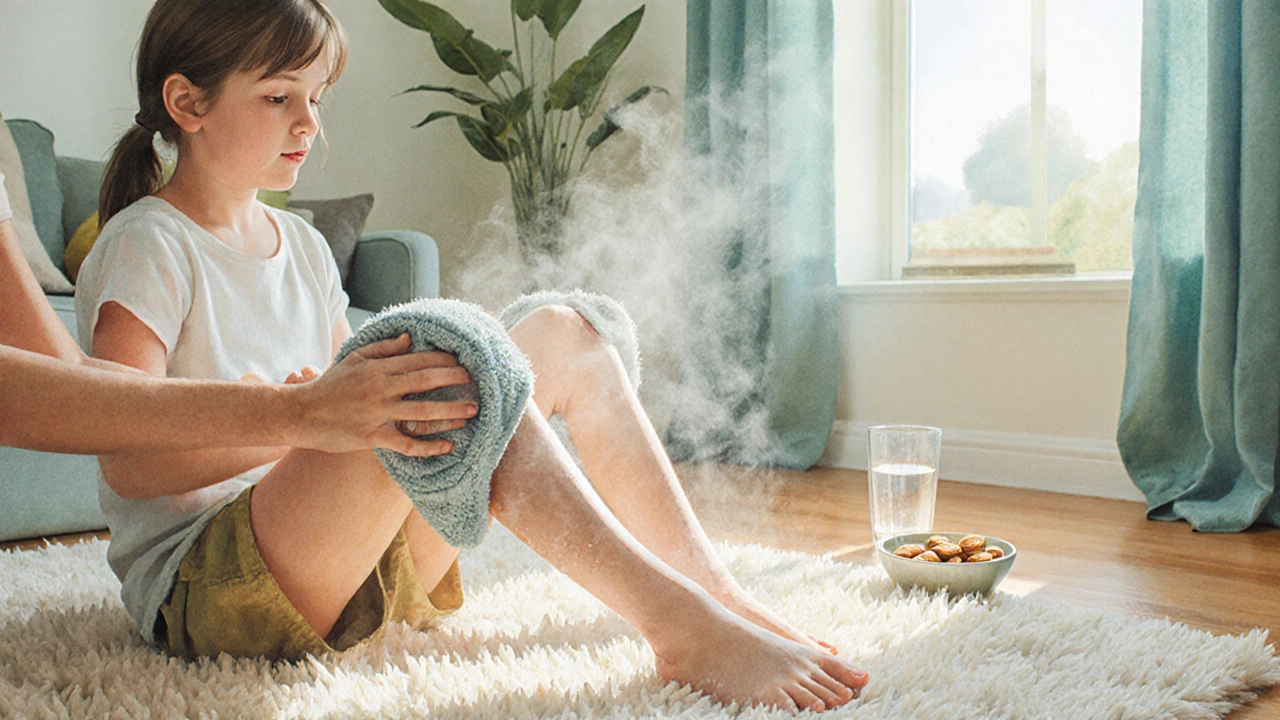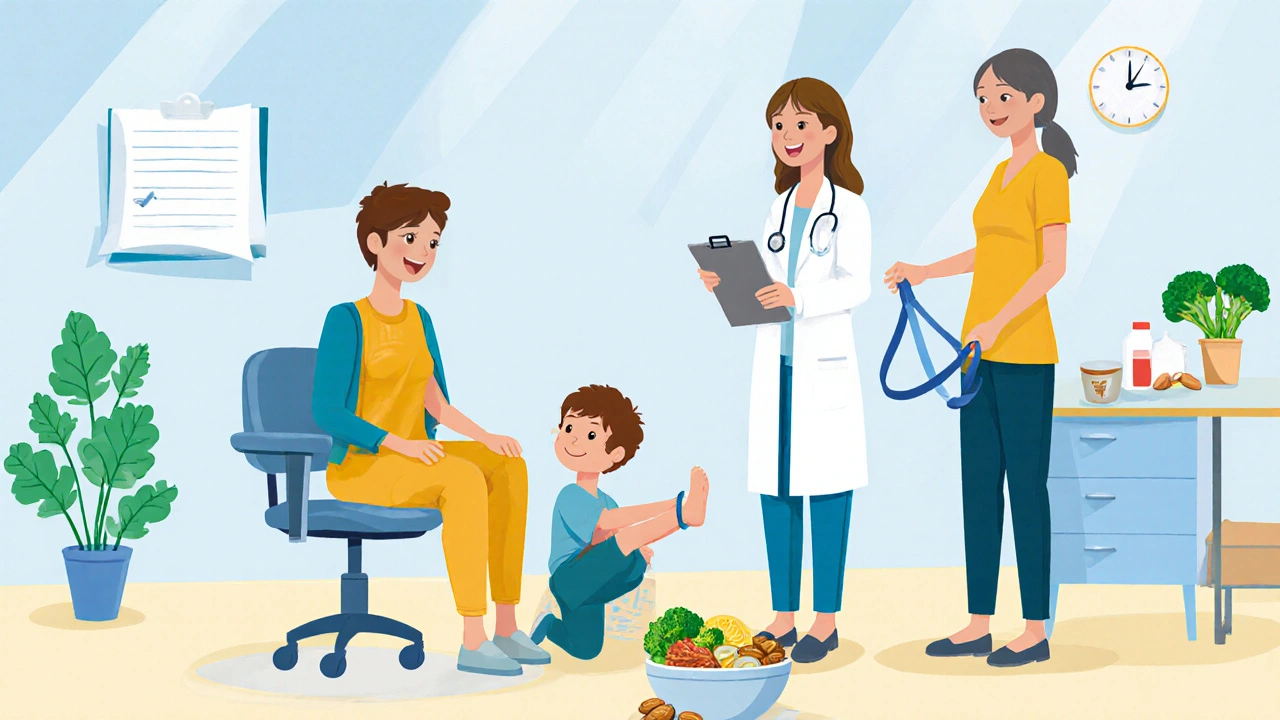Child Muscle Spasm Trigger Identifier
Identify Potential Triggers
Answer the following questions to identify possible causes of your child's muscle spasms.
Potential Triggers
Dehydration
Common in active children, especially during hot weather or intense sports.
Electrolyte Imbalance
Low calcium or magnesium levels can destabilize muscle nerves.
Overexertion
Long practice sessions without proper warm-up lead to muscle fatigue.
Neurological Disorders
Conditions such as Epilepsy or Cerebral Palsy may present spasms.
Medication Side Effects
Some asthma inhalers or stimulant medications can provoke muscle twitching.
Analysis Results
Answer the questions above to get personalized trigger analysis.
Key Takeaways
- Identify the trigger - dehydration, nutrient gaps, or neurological conditions.
- Use gentle stretching and warm compresses for immediate relief.
- Ensure a balanced diet rich in calcium and magnesium.
- Know when to call a doctor - frequent episodes, loss of consciousness, or associated developmental concerns.
- Follow a coordinated plan with healthcare professionals, including physical therapy and, if needed, medication.
When a muscle spasm is an involuntary contraction of a muscle that can cause sudden pain, stiffness, or jerking movements shows up in a child, the first reaction is often panic. Parents wonder whether it’s something simple like a cramp or a sign of a deeper medical issue. This guide walks you through the most common causes, quick home tricks, and when professional help is essential, so you can stay calm and act confidently.
What Exactly Is a Spasm in Kids?
A spasm, sometimes called a muscle cramp or twitch, is a brief, uncontrolled tightening of a muscle or group of muscles. In children, spasms can appear in the legs, arms, neck, or facial muscles. They differ from seizures because they are usually short (seconds to a few minutes), stay localized, and don’t involve loss of consciousness.
Common descriptors include:
- Acute: Sudden, sharp pain that may subside after a few seconds.
- Recurrent: Multiple episodes over days or weeks.
- Persistent: A spasm that lasts longer than 10 minutes and doesn’t release.
Understanding the pattern helps decide whether a home approach will suffice or a doctor’s evaluation is needed.
Top Triggers to Watch For
Most spasms in children stem from lifestyle or nutritional issues, but certain medical conditions raise the stakes.
- Dehydration: Kids who are active, live in hot climates, or skip water during sports are prime candidates.
- Electrolyte imbalances: Low calcium or magnesium levels can destabilize muscle nerves.
- Overexertion: Long practice sessions without proper warm‑up lead to muscle fatigue.
- Neurological disorders: Conditions such as Epilepsy a brain disorder causing recurrent seizures or Cerebral palsy a group of movement disorders arising from brain injury at birth may present spasms as part of their symptom complex.
- Medication side effects: Some asthma inhalers or stimulant medications can provoke muscle twitching.

Quick Home Relief Steps
Before you dial a doctor, try these safe, low‑tech techniques. They work for most mild, isolated spasms.
- Gentle Stretch: Slowly extend the affected limb until a mild pull is felt. Hold for 15-30 seconds, then release.
- Warm Compress: Apply a warm (not hot) towel or heating pad for 5 minutes to relax the muscle fibers.
- Massage: Light circular motions can increase blood flow and reduce tension.
- Hydration Boost: Offer water or an electrolyte solution-especially after sports.
- Nutrition Check: Incorporate calcium‑rich foods (milk, cheese, leafy greens) and magnesium sources (nuts, seeds, whole grains) into meals.
If the spasm fades within a few minutes, it was likely a simple cramp. Keep a log of frequency, triggers, and relief methods; the data becomes valuable for doctors if the problem persists.
When a Spasm Signals Something Bigger
Certain red flags mean it’s time to seek professional care:
- Spasms lasting longer than 10 minutes or occurring more than three times a day.
- Accompanying weakness, numbness, or loss of coordination.
- Changes in speech, vision, or consciousness.
- Family history of neurological disorders.
- Signs of underlying disease such as abnormal growth, developmental delays, or persistent pain.
These symptoms could point to Dystonia a movement disorder causing sustained muscle contractions and abnormal postures, an early sign of metabolic issues, or a seizure disorder.
Professional Evaluation: What to Expect
A pediatrician will start with a detailed history and physical exam. Depending on findings, they may order:
- Blood tests: Calcium, magnesium, potassium, and vitamin D levels.
- Electromyography (EMG): Measures electrical activity in muscles to differentiate cramps from neurologic spasms.
- Imaging: MRI or CT scans if a central nervous system cause is suspected.
These results guide the next steps, which may involve a referral to a pediatric neurologist, a dietitian, or a physical therapist.

Long‑Term Management Plans
For recurring spasms, a multi‑layered approach usually works best.
1. Lifestyle Adjustments
- Set regular water‑break reminders during school and sports.
- Schedule a balanced snack containing protein and complex carbs before intense activity.
- Include a daily stretch routine-10 minutes of gentle yoga or pilates moves.
2. Targeted Nutrition
Consult a registered dietitian to personalize intake. A typical plan for a 10‑year‑old might look like:
- Milk (250ml) = 300mg calcium
- Almonds (30g) = 80mg magnesium
- Broccoli (½ cup) = 45mg calcium
Supplements are only recommended after blood work confirms a deficiency.
3. Physical Therapy
A licensed Physical therapist a health professional who designs exercise programs to improve movement and reduce pain can teach:
- Progressive strengthening to prevent muscle fatigue.
- Proprioceptive training that helps the brain better control muscles.
4. Medication (When Needed)
Doctors may prescribe muscle relaxants (e.g., baclofen) or antispasticity agents if spasms are severe and affect daily life. Medications are always a last resort after lifestyle and therapy have been optimized.
Comparing Home vs. Medical Interventions
| Aspect | Home Remedies | Medical Interventions |
|---|---|---|
| Speed of Relief | Immediate (minutes) | Variable (hours to days) |
| Cost | Low‑cost (water, stretches) | Higher (consults, tests, meds) |
| Side Effects | None | Potential (sedation, weakness) |
| When to Use | Isolated, short‑lasting cramps | Frequent, prolonged, or neurologically linked spasms |
| Long‑Term Benefit | Improves hydration & flexibility | Addresses underlying causes (deficiencies, neurological disease) |
Frequently Asked Questions
How can I tell the difference between a cramp and a seizure?
A cramp is usually localized, lasts seconds to a few minutes, and the child stays fully aware. A seizure often involves loss of consciousness, rhythmic jerking of multiple body parts, and may be followed by confusion. If you’re unsure, treat it as a seizure and seek emergency care.
Do electrolyte drinks help prevent spasms?
Yes, especially for active children. Look for drinks that contain balanced sodium, potassium, calcium, and magnesium. Avoid those with excessive sugar.
Can stress cause muscle spasms in kids?
Emotional stress can increase muscle tension, making spasms more likely. Teaching relaxation techniques-deep breathing, guided imagery-can be part of the management plan.
When should I consider a referral to a neurologist?
If spasms are frequent, involve multiple muscle groups, or are accompanied by developmental concerns, a neurologist can rule out conditions like Epilepsy or dystonia.
Are there any safe over‑the‑counter options?
Topical magnesium creams and calcium‑vitamin D supplements are generally safe, but always confirm dosage with a pediatrician before starting.
Next Steps for Parents
1. Start a spasm diary: Note time, activity, food/drink, and what you tried.
2. Check hydration and diet today: Offer water before and after play, add a calcium‑rich snack.
3. Try a gentle stretch routine: 5 minutes after school, focusing on calves and hamstrings.
4. Schedule a pediatric check‑up if spasms happen more than twice a week or you spot any red flags.
5. Follow up with specialists as advised-physiotherapy can make a huge difference in long‑term control.
By blending quick home fixes with professional guidance, you can reduce the frequency of child muscle spasms and keep your little one moving comfortably.

Brett Snyder
Ths guide is a total waste of ink. Anybody who reads it thinks they're smarter than the rest of us, but it's just a collection of basic stuff anyone with a middle school biology class already knows. The writer pretends to be some kind of expert while the real answer is simple: keep kids hydrated, feed them calcium and get them moving properly. If you think this is groundbreaking, you must be living under a rock. Stop buying overpriced books and just check the water bottle.
Nidhi Jaiswal
Kids get cramps when they forget to drink water and when they run a lot. A quick stretch and a sip of water usually fix it. Watching the child’s diet can also help. Keep a note of when it happens and what they ate before.
Sunil Sharma
Hey folks, just wanted to add that sometimes anxiety can sneak in and tighten muscles without anyone noticing. A calm environment and a few deep breaths can go a long way. Also, try to involve the child in choosing the snack that’s rich in calcium – it makes them feel in control and improves nutrition.
Leah Robinson
Great guide! 😊💪 I’ve been using the warm compress trick and it’s a lifesaver after soccer practice. Don’t forget the simple thing: a quick calf stretch before bed can prevent those midnight jerks. Keep the vibe positive and the kids will trust the routine. 🌟
Abhimanyu Lala
Yo this is basic stuff yo. Hydration + stretch = less spasms. No need for fancy labs.
Richard Sucgang
While the article commendably touches upon electrolyte balance, it fails to elucidate the underlying physiologic mechanisms with sufficient rigor. One would anticipate a discussion of the sodium‑potassium pump and the role of intracellular calcium sequestration. Moreover, the omission of peer‑reviewed citations diminishes its scholarly merit.
Russell Martin
Pro tip: set a reminder on your phone to hydrate every hour during sports. It’s a tiny habit that prevents most cramping episodes.
Jenn Zee
The phenomenon of muscle spasms in children, though often dismissed as trivial, warrants a nuanced appreciation.
The first reaction in many households is panic, a response amplified by vivid descriptions of sudden jerking movements.
Parents, understandably, seek immediate remedies, yet the most effective strategies are grounded in preventive care.
Hydration stands as the cornerstone of muscular health, especially in active youths who expend fluids rapidly.
Electrolyte balance, encompassing calcium, magnesium, potassium, and sodium, further stabilizes neuronal signaling.
Overexertion without proper warm‑up can overtax muscle fibers, precipitating involuntary contractions.
Conversely, neurological disorders such as epilepsy or cerebral palsy may masquerade as simple cramps, demanding professional evaluation.
The guide’s emphasis on gentle stretching aligns with physiotherapeutic principles that promote muscle pliability.
Applying a warm compress facilitates blood flow, which in turn eases tension within the sarcomere.
Dietary considerations, notably the inclusion of dairy, leafy greens, nuts, and seeds, ensure a steady supply of essential minerals.
Logging each episode in a diary provides invaluable data for clinicians, enabling pattern recognition and targeted intervention.
When red flags emerge-prolonged duration, loss of consciousness, or multifocal involvement-urgent medical assessment becomes indispensable.
Diagnostic modalities such as serum electrolyte panels, electromyography, and neuroimaging can delineate the etiology.
Interdisciplinary collaboration among pediatricians, neurologists, dietitians, and physical therapists yields the most comprehensive care plan.
Ultimately, a balanced combination of home‑based measures and timely professional input empowers parents to mitigate the distress associated with child muscle spasms.
don hammond
Oh great, another “ultimate guide” that tells us to drink water. Because we didn’t know that already, right? 🙄
Ben Rudolph
Honestly, if parents aren’t tracking every snack, they’re being negligent. It’s not optional.
Ian Banson
Agree, the article is fluff.
marcel lux
While the points raised are valid, it would be beneficial to supplement them with evidence‑based references to enhance credibility.
Charlotte Shurley
I appreciate the emphasis on anxiety; mental health often intersects with physical symptoms.
Steph Hooton
Dear all, I must extol the virtue of maintaining a consistent hydration schedule; indeed, it is the most efficacious prophylactic against involuntary muscular contractions, and I recommend its rigorous implementation.
Judson Voss
The concise advice is apt, but it neglects the underlying biochemical pathways that merit discussion.
Jessica Di Giannantonio
Such an oversight is nothing short of a tragedy for the unsuspecting parent, who is left in the dark about the true nature of their child’s suffering.
RUCHIKA SHAH
In the grand scheme, we see that knowledge is power, yet the over‑simplification of such matters strips people of agency.
Justin Channell
👍 Great point! Adding citations will definitely boost the guide’s authority.
Basu Dev
It is heartening to observe the growing awareness of the psychological components underlying physiological manifestations. The interplay between stress hormones and muscular excitability is a field ripe for further exploration. By integrating mindfulness practices with physical therapy, one can achieve a synergistic effect that transcends the mere alleviation of cramps. Moreover, educating caregivers about these connections empowers them to adopt a holistic approach, ultimately fostering resilience in the child. Such comprehensive strategies underscore the need for interdisciplinary collaboration.
Krysta Howard
While the elegance of the language is noted, the real issue remains: parents must act now, not later. 🚀